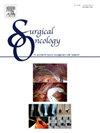腹膜恶性肿瘤患者的加压腹腔内气溶胶化疗(PIPAC):一项单中心、单臂、开放标签的II期临床试验
IF 2.4
4区 医学
Q3 ONCOLOGY
引用次数: 0
摘要
简介:加压腹膜内气溶胶化疗(PIPAC)是一种很有希望的姑息性治疗腹膜恶性肿瘤患者谁不候选人的治愈性手术。本研究旨在评估在单一癌症中心实施PIPAC计划的有效性和可行性。方法:进行了一项开放标签、单臂、II期研究,纳入了不同来源的腹膜肿瘤患者。参与者接受双向化疗(静脉注射和PIPAC)。主要终点是以病理反应衡量的PIPAC疗效,而次要终点包括技术的安全性和可行性、生活质量和临床结果。结果:从2021年3月至2024年3月,筛选了32例患者,入组25例,共进行了58例PIPAC手术。并发症发生率低,严重手术并发症发生率为1.7%,CTCAE 3级并发症发生率为3.4%。在56%的病例中观察到主要的病理反应,7例患者(28.0%)在至少两次PIPAC治疗后接受了治愈意图的细胞减少手术。重复PIPAC后腹膜癌指数(PCI)和腹膜回归评分(PRGS)均降低(p = 0.016和p = 0.047)。第一次PIPAC术后腹水体积也显著减少(p = 0.001)。中位总生存期(OS)为9.6个月,缓解患者(PRGS 1-2)表现出更好的临床结果(OS: 21.0 vs. 5.5个月,p结论:PIPAC可安全联合腹膜恶性肿瘤患者全身化疗,有效控制腹水,达到主要病理反应。需要进一步的研究来确定其潜在的生存益处。本文章由计算机程序翻译,如有差异,请以英文原文为准。
Pressurized intraperitoneal aerosol chemotherapy (PIPAC) in patients with peritoneal malignancies: a monocentric, single-arm open-label phase II clinical trial
Introduction
Pressurized intraperitoneal aerosol chemotherapy (PIPAC) is a promising palliative treatment for patients with peritoneal malignancies who are not candidates for curative surgery. This study aimed to assess the efficacy and feasibility of implementing a PIPAC program at a single cancer center.
Methods
An open-label, single-arm, phase II study was conducted, enrolling patients with peritoneal tumors of various origins. Participants received bidirectional chemotherapy (intravenous and PIPAC). The primary endpoint was PIPAC efficacy measured as pathological response, while secondary endpoints included safety and feasibility of the technique, quality of life, and clinical outcomes.
Results
From March 2021 to March 2024, 32 patients were screened, and 25 were enrolled, resulting in 58 PIPAC procedures. The complication rate was low, with severe surgical complications occurring in 1.7 % of procedures and CTCAE grade 3 complications in 3.4 %. A major pathological response was observed in 56 % of cases, and seven patients (28.0 %) underwent curative-intent cytoreductive surgery after at least two PIPAC treatments. Both the Peritoneal Cancer Index (PCI) and the Peritoneal Regression Score (PRGS) decreased after repeated PIPAC (p = 0.016 and p = 0.047, respectively). Ascites volume also decreased significantly after the first PIPAC (p = 0.001). The median overall survival (OS) was 9.6 months, with responding patients (PRGS 1–2) showing better clinical outcomes (OS: 21.0 vs. 5.5 months,p < 0.001; PFS: 8.2 vs. 2.4 months,p < 0.001) and quality of life (p = 0.003).
Conclusion
PIPAC can be safely combined with systemic chemotherapy in patients with peritoneal malignancies, demonstrating efficacy in controlling ascites and achieving major pathological response. Further studies are necessary to determine its potential survival benefits.
求助全文
通过发布文献求助,成功后即可免费获取论文全文。
去求助
来源期刊

Surgical Oncology-Oxford
医学-外科
CiteScore
4.50
自引率
0.00%
发文量
169
审稿时长
38 days
期刊介绍:
Surgical Oncology is a peer reviewed journal publishing review articles that contribute to the advancement of knowledge in surgical oncology and related fields of interest. Articles represent a spectrum of current technology in oncology research as well as those concerning clinical trials, surgical technique, methods of investigation and patient evaluation. Surgical Oncology publishes comprehensive Reviews that examine individual topics in considerable detail, in addition to editorials and commentaries which focus on selected papers. The journal also publishes special issues which explore topics of interest to surgical oncologists in great detail - outlining recent advancements and providing readers with the most up to date information.
 求助内容:
求助内容: 应助结果提醒方式:
应助结果提醒方式:


